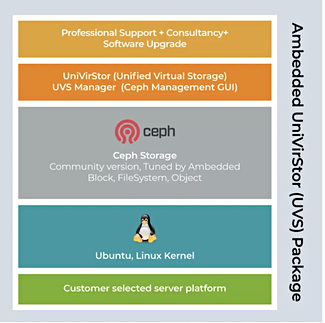Data intelligence biz Alation has gained accreditation from the Infocomm Media Development Authority (IMDA) of Singapore enabling it to sell more effectively to government and large enterprise buyers there.
…
Ambedded has announced its UniVirStor Ceph storage software appliance including the OS, kernel, ceph storage and GUI management. It can run on any server platform.

…
The British Standards Institution has announced the first international guidelines on how organizations can deploy and manage AI responsibly and safely. The guidance lays out how to establish, implement, maintain and continually improve an AI management system, with a focus on safeguards to facilitate context-based AI risk assessments.
Databricks VP of Generative AI Naveen Rao said: “We believe in adequate and effective regulation of AI, but we should be careful not to overregulate AI, including LLMs and open source AI. Productivity enhancements from AI can be seen in many forms, like improving customer and employee experiences. These applications of AI and many others we’re seeing do not appear to be negatively impacting jobs, although there will be disruption in various areas, as with any technological revolution.”
“Any new regulation must not be at the cost of stifling smaller startups and academic researchers from being able to do their work and research. The more we understand these models, the more we can share ideas on how to safely shape a future with AI.”
…
Cohesity announced the appointment of Olivier Savornin as Group VP of Sales for Europe, Middle East and Africa (EMEA). Savornin will lead Cohesity’s sales and customer engagement efforts in the region, with a focus on driving the adoption of Cohesity’s AI-powered modern data security and management products. Cohesity also appointed Fraser Hutchison as its Area VP of Sales for UK, Benelux, Ireland, Sweden, Norway and Finland (Northern EMEA).
…
The 15th MRAM Global Innovation Forum, sponsored by the IEEE Magnetics Society and Samsung, was held after the IEDM conference concluded on Thursday, Dec. 14. In addition, a special poster session dedicated to MRAM (magnetoresistive RAM memory) was held during the IEDM on Tuesday, Dec. 12. Here is a link to the MRAM Global Innovation Forum program with the agenda and abstracts of all the papers.
…
SVP Hybrid Cloud Engineering Octavian Tanese has left NetApp and joined Hitachi Vantara as its chief product officer. Tanase will drive the vision, strategy, development, and execution of the company’s product portfolio. He reports directly to CEO Sheila Rohra, and said: “My goal is to help the company expand its leadership position by harnessing the power of generative AI and other emerging technologies to drive even greater innovation in its portfolio.
…
NetApp has hired Ashish Dhawan as its new SVP of Global Cloud Sales, where he will focus on expanding the company’s presence in the cloud services domain. This appointment comes on the heels of NetApp appointing ex-Commvault sales head Riccardo Di Blasio as SVP of North America Sales. Dhawan joins the company from AWS where he most recently led world-wide sales for enterprise cloud workloads, in addition to more than two decades of international experience driving high growth. Commvault now has a CRO vacancy.
…
Vector database supplier Pinecone announced Pinecone serverless that, it claims, completely eliminates the need for developers to provision or manage infrastructure and allows them to build GenAI applications more easily and bring them to market much faster. Companies like Notion, CS Disco, Gong and more thab a hundred others are already using Pinecone Serverless. It features:
- Separation of reads, writes, and storage to reduce costs for all workloads.
- Industry-first architecture with vector clustering on top of blob storage provides low-latency, always fresh vector search over practically unlimited data sizes at a low cost.
- Industry-first indexing and retrieval algorithms built from scratch to enable fast and memory-efficient vector search from blob storage without sacrificing retrieval quality.
- Multi-tenant compute layer provides retrieval for thousands of users, on demand.
This enables a serverless experience in which developers don’t need to provision, manage, or even think about infrastructure, as well as usage-based billing that lets companies pay only for what they use.
…
Samsung is developing Low Latency Wide I/O (LLW) DRAM with high bandwidth performance, 128GBps, for on-device LLM computing. it uses Fan-Out Wafer-Level Packaging (FOWLP). Check out Tom’s Hardware story here.
…
HCI edge-focused supplier Scale Computing is partnering RackTop and making its RackTop BrickStor Security Platform available on Scale kit. It offers real-time defense against live ransomware attacks, insider threats, and data breaches. BrickStor SP provides the ability to prevent data exfiltration from privileged and trusted users and to stop malware at the storage processor, while ensuring production data remains online and available to all uncompromised users. This, at least, in the sales pitch. BrickStor SP, we’re told, can be deployed as a Virtual Appliance within Scale Computing Hypercore clusters, delivering reliable infrastructure consolidation.
,…
Transactional/analytic database supplier SingleStore is launching its Pro Max product on January 24, featuring a promised 1,000x faster vector search and on-demand compute service for GPUs/CPUs. It mentions feature names such as Scope vector search, Aura compute service and Kai for JSON/BSON analytics. Click here to reserve your spot.
CEO Raj Verma told William Blair analyst Jason Ader: “We’ve raised $415 million in cash and currently have roughly $200 million left from our last funding round led by Goldman Sachs. We’ve exceeded $100 million in ARR, and approximately 40 percent of our business is consumption-based. This year, we expect to grow greater than 30 percent. Today, we have more than 300 enterprise customers, and we are adding more than 1 customer per day through our self-serve model.”
…
Data protector Veeam has updated its ProPartner Network supporting 35,000 technology partners in more than 150 countries. The program updates are focused on supporting partner profitability in a more predictable way while ensuring the partner’s business with Veeam is safeguarded. They get:
- Greater profit margins for partners on the front-end, and greater protections for these margins
- Expanded deal registration eligibility and non-standard pricing scenarios
- Enhanced sales and technical training
- Increased joint customer wins and marketing support
…
Veeam announced the findings of its 5th annual Data Protection Trends Report. The findings show that IT leaders are feeling less protected about their ability to recover and restore data in the event of a cyberattack. Highlights include:
- Ransomware continues to be a ‘when’ not ‘if’: 76 percent of organizations were attacked at least once in the past 12 months. Only 13 percent said they can successfully orchestrate recovery during disaster recovery.
- Cyberattacks are the #1 cause of outages: Listed as the most common and impactful causes of business outages across organizations for the fourth consecutive year, cyberattacks illustrate the growing need for aggressive backup strategies. Only 32 percent believe they can recover from a small attack in one week, meaning there’s a growing gap between what data protection business units expect and what IT services can deliver.
- Data protection budgets are accelerating: Budgets are projected to grow by 6.6 percent and 92 percent of organizations expect to spend more on data protection in 2024.
- Data protection and security are becoming more integrated: The most common and important aspect of modern data protection are solutions that integrate with cyber tools. 41 percent said they consider mobility in cloud scenarios as the most important characteristic of a modern solution.
- Cyberattacks’ impact on digital transformation: Cyber threats and ESG goals are the biggest inhibitors to digital transformation.
You can find the full report here.
…
Datacenter virtualizer VergeIO, which takes takes HCI HW and SW and melds it into a software-defined, multi-tenant, virtual datacenter, has provided documentation explaining how to exit VMware and use its products instead. VMware leavers should check out the cost, support, complexity, HW choices, and migration ease of VMware alternatives, VergeIO said.








